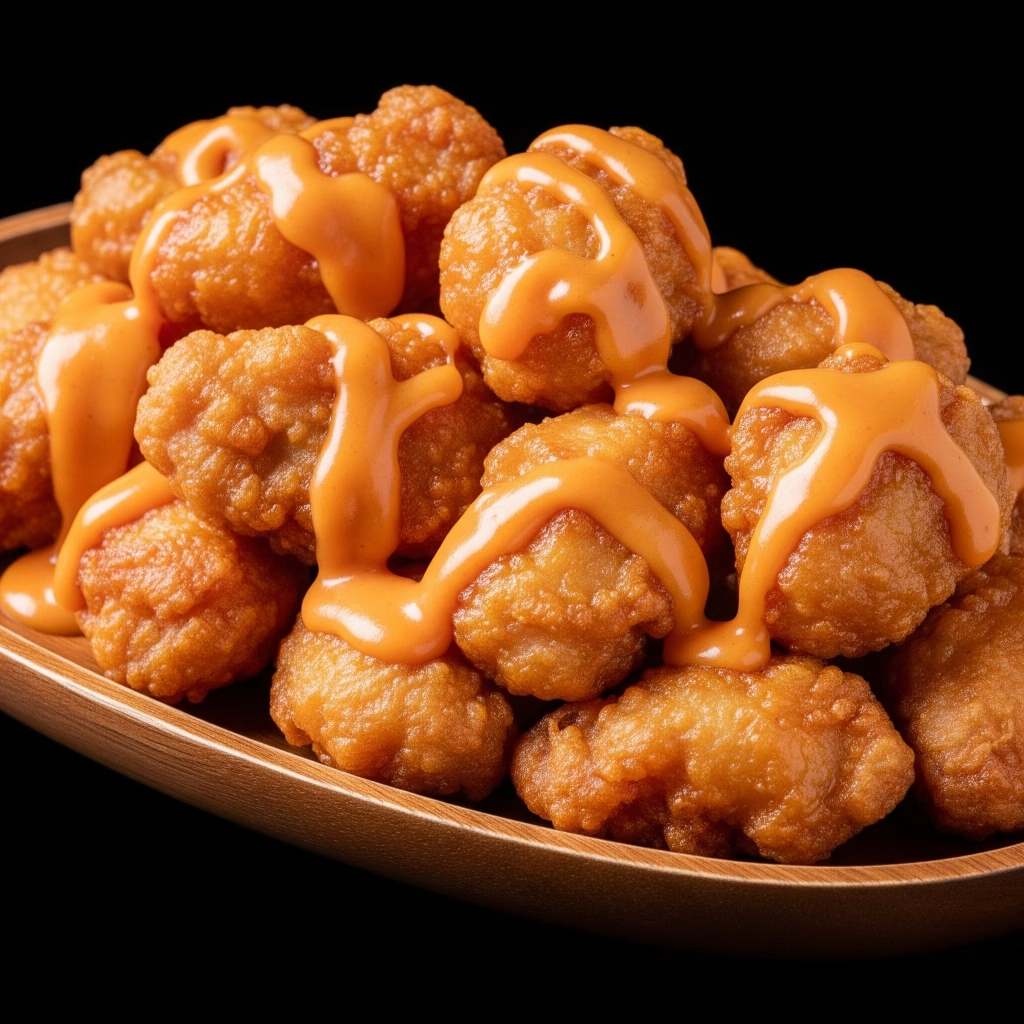Chinese Orange Chicken is a beloved staple of American-Chinese cuisine—crispy bite-sized chicken pieces coated in a sweet, tangy, and slightly spicy orange glaze.
While it originated as a Western interpretation of traditional Chinese flavors, this dish has taken on a life of its own in homes and restaurants across the world. The bright citrus notes of fresh orange juice combined with soy sauce, garlic, ginger, and just a hint of chili, strike the perfect harmony between sweet and savory. Often paired with steamed rice or noodles, Orange Chicken is the go-to comfort food when you’re craving something sticky, crispy, and flavor-packed.
Table of Contents
Ingredients
For the Chicken:
- 800 g (1.75 lbs) boneless chicken thighs or breast, cut into bite-sized pieces
- 2 eggs
- 1 cup all-purpose flour
- 1 cup cornstarch
- Salt and pepper to taste
- Oil for deep frying (vegetable or canola)
For the Orange Sauce:
- 1 tablespoon vegetable oil
- 2 cloves garlic, minced
- 1 tablespoon fresh ginger, minced
- 1 teaspoon red chili flakes (optional, for spice)
- ¾ cup orange juice (freshly squeezed preferred)
- Zest of 1 orange
- 2 tablespoons soy sauce
- 1 tablespoon rice vinegar
- 3 tablespoons sugar (adjust to taste)
- 1 tablespoon hoisin sauce (optional, for depth)
- 2 teaspoons cornstarch mixed with 2 tablespoons water (slurry)
- 1 teaspoon sesame oil (optional, for aroma)
Garnish (Optional):
- Sliced green onions
- Toasted sesame seeds
- Orange zest or wedges
Serves
Serves: 4 people
Prep Time: 20 minutes
Cooking Time: 25 minutes
Total Time: 45 minutes
Step-by-Step Instructions
Step 1: Prep the Chicken
- Cut chicken into 1-inch cubes.
- Season with a pinch of salt and pepper.
- Beat the eggs in one bowl. In another bowl, mix flour and cornstarch.
- Dip each piece of chicken into egg, then coat it thoroughly in the flour mixture. Shake off excess.
Step 2: Fry the Chicken
- Heat oil in a deep pan or wok over medium-high heat to 175°C (350°F).
- Deep-fry chicken in small batches for 5–6 minutes until golden and crispy.
- Remove and drain on paper towels.
Tip: For ultra-crispy texture, double-fry each batch for 1–2 more minutes.
Step 3: Make the Orange Sauce
- In a separate pan or wok, heat 1 tbsp oil.
- Sauté garlic, ginger, and chili flakes for about 30 seconds until fragrant.
- Add orange juice, orange zest, soy sauce, vinegar, sugar, and hoisin sauce.
- Bring to a simmer and let reduce slightly (3–4 minutes).
- Stir in the cornstarch slurry and cook until the sauce thickens and turns glossy.
- Finish with a drizzle of sesame oil for depth.
Step 4: Coat the Chicken
- Add the fried chicken pieces to the sauce and toss quickly to coat evenly.
- Cook for 1–2 minutes to absorb the flavors.
Step 5: Garnish and Serve
- Plate the chicken and garnish with sesame seeds, chopped green onions, or orange zest.
- Serve immediately over a bed of steamed rice or noodles.
Serving Suggestions
- With Steamed Jasmine or Basmati Rice: The perfect canvas for soaking up the sauce.
- With Fried Rice: Double the flavor for a restaurant-style meal at home.
- With Stir-Fried Veggies: Broccoli, bell peppers, or bok choy balance the richness.
- In Lettuce Wraps: For a fresh and crunchy twist.
- In Bao Buns: Create mini orange chicken sliders!

Tips for Perfect Orange Chicken
- Use Chicken Thighs for Juiciness: Breast works, but thighs offer richer flavor and stay tender.
- Double Fry for Extra Crunch: It’s a trick most takeouts use for lasting crispiness.
- Fresh Orange Juice is Key: Bottled juice often lacks zest and natural tang.
- Balance Your Sauce: Adjust sweetness or acidity to suit your palate.
- Serve Immediately: The crispiness fades the longer it sits in sauce.
Healthier Alternatives
- Air Fry the Chicken: Use an air fryer at 200°C (400°F) for 15–18 minutes with light oil spray.
- Bake Instead of Fry: Bake coated chicken at 220°C (425°F) for 25 minutes, flipping halfway.
- Use Chicken Breast: Slightly leaner and lower in fat.
- Low-Sugar Sauce: Replace sugar with honey or reduce quantity for less sweetness.
- Steamed Version: Skip the frying and stir-fry the chicken directly in sauce for a lighter meal.
Creative Variations
- Spicy Orange Chicken: Add more chili flakes or a dash of Sriracha.
- Orange Cauliflower: Vegan alternative using roasted or battered cauliflower florets.
- Orange Shrimp: Quick stir-fry shrimp in the same orange glaze for a seafood twist.
- Orange Chicken Tacos: Serve in warm tortillas with cabbage slaw and lime crema.
- Gluten-Free Orange Chicken: Use gluten-free soy sauce and cornstarch instead of flour.
Common Mistakes to Avoid
- Using Bottled Orange Juice: It often tastes flat or overly sweet.
- Overcooking Chicken: Makes it dry—fry only until golden and cooked through.
- Skipping the Cornstarch Slurry: The sauce won’t thicken properly.
- Overcrowding the Frying Pan: Lowers oil temperature and results in soggy coating.
- Letting Chicken Sit Too Long in Sauce: Causes the crispy texture to soften.
History of Chinese Orange Chicken
1. Western Origins with Chinese Influence
Despite its name, Orange Chicken is not a traditional dish found in mainland China. It was actually created in the United States by Chinese-American chefs looking to adapt traditional flavors to local tastes. Inspired by sweet and sour pork and similar citrus-based stir-fries, this dish became popular in Chinese-American restaurants during the 1980s and 1990s, particularly on the West Coast.

2. Panda Express and Global Popularity
The real explosion of Orange Chicken came in 1987, when Chef Andy Kao introduced it at a Panda Express in Hawaii. It was an immediate hit, combining familiar crispy textures with a bold sweet-tangy orange sauce. Since then, it’s become the most iconic item on the Panda Express menu and a globally recognized dish associated with Chinese-American cuisine.
3. Cultural Significance and Evolution
Orange Chicken reflects the culinary journey of Chinese immigrants who balanced authenticity with American tastes. While traditional Chinese cuisine rarely uses oranges in savory dishes, this dish showcases how culinary traditions evolve across borders. Today, Orange Chicken continues to evolve—home cooks create spicy, healthy, or even vegan versions, proving its adaptability and timeless appeal.
FAQs about Chinese Orange Chicken
1. Is Orange Chicken actually Chinese?
Not exactly. It was created in the U.S. and is a Chinese-American dish inspired by traditional flavors.
2. Can I make it without frying?
Yes. You can air fry or bake the chicken for a lighter version.
3. Is it spicy?
Mildly, if you add red chili flakes. You can make it spicier or keep it sweet.
4. How do I keep the chicken crispy?
Double-frying and serving immediately after tossing in sauce helps retain crispiness.
5. Can I freeze Orange Chicken?
You can freeze the cooked chicken separately, but it’s best to make the sauce fresh.
6. Can I use bottled orange juice?
Yes, but fresh orange juice and zest offer better flavor.
7. What’s the best cut of chicken to use?
Thighs for juiciness, breasts for a leaner dish.
8. What if I don’t have rice vinegar?
Substitute with apple cider vinegar or white vinegar in equal amounts.
9. How do I thicken the sauce?
Use cornstarch mixed with water (slurry) and simmer the sauce until thickened.
10. Can I make it gluten-free?
Yes—use gluten-free soy sauce and swap flour for gluten-free flour or rice flour.
Chinese Orange Chicken is a delightful fusion dish that proves comfort food doesn’t need to be complicated to be extraordinary. With its crispy golden coating and irresistible citrus glaze, it satisfies cravings for both sweet and savory in every bite. Whether you’re replicating your favorite takeout meal or introducing friends to bold Chinese-American flavors, this dish is sure to be a crowd-pleaser. Plus, with countless variations and healthier options, it’s a recipe you can revisit over and over again. So gather your ingredients, squeeze those fresh oranges, and bring this vibrant, zesty classic to life in your own kitchen.


